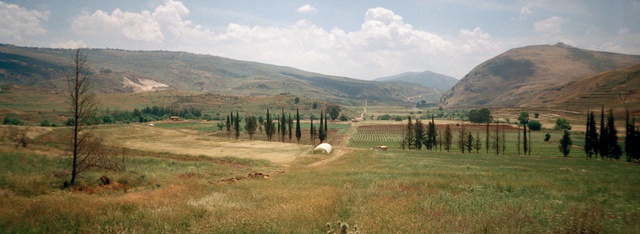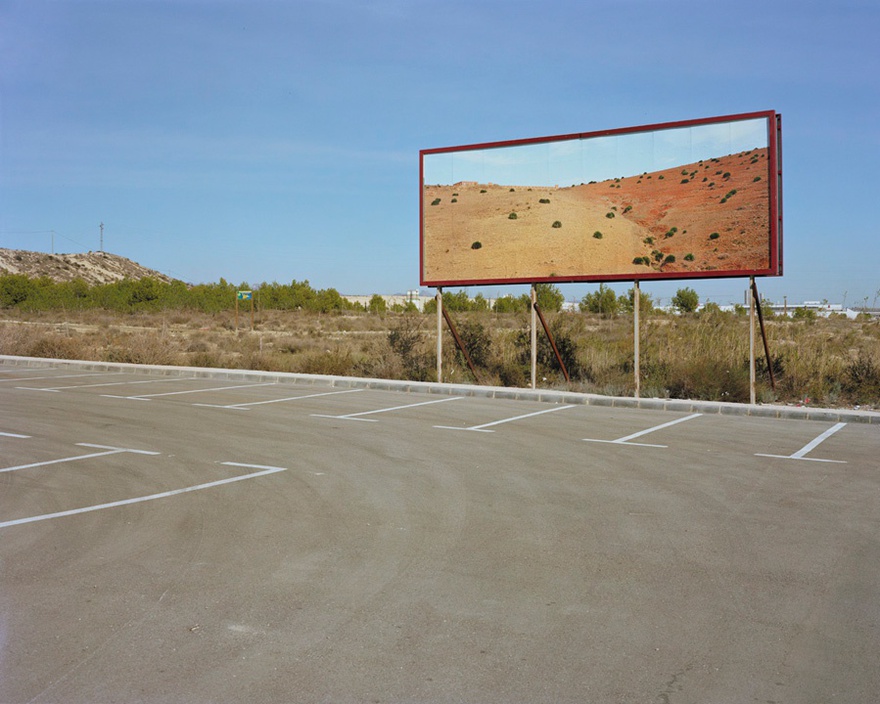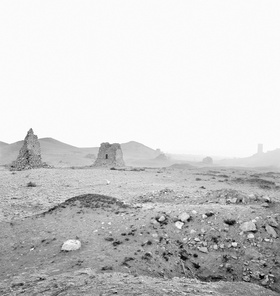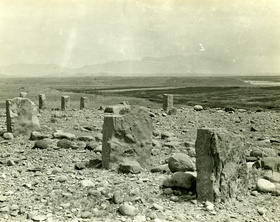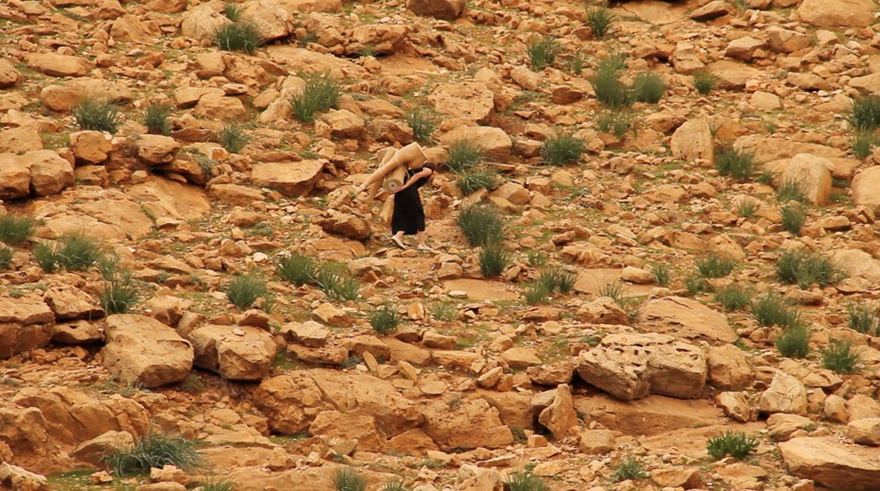Interviews
My Sister Who Travels
Martina Caruso in conversation with Sheyma Buali
The Mediterranean, often referred to as the 'cradle of civilization', is a region with a deep-set history of peoples, languages and religions conflicting and merging. The liquid borders make it a place where the difficulty of migration has currently come to light as a major crisis in contemporary humanity. Yet still, as curator Martina Caruso has noted, it is not a place without its own picturesque cliché of being 'the vacationers' wonderland'. With these ideas, Caruso curated the exhibition My Sister Who Travels (The Mosaic Rooms, 18 July–30 August 2014), which featured six contemporary artists, Corinne Silva, Halida Boughriet, Jananne Al-Ani, Noor Abed, Paola Yacoub and Ursula Schulz-Dornburg, who were presented alongside archival images by Victorian archaeologist Esther Van Deman. The exhibition examined issues of movement versus stagnation, history and the contemporary alongside the visible and the invisible. In this interview, Sheyma Buali speaks with Caruso about these ideas and how various ways of looking at landscapes tell different narratives.
Sheyma Buali: In My Sister Who Travels, you start from a point that you address as a western-male preoccupation and circumvent it by bringing in the eastern-female view of landscape. The text around the exhibition addresses the ways in which 'contemporary women artists engage politically with post-colonial themes in their practices'. What is the impetus behind this two-fold binary in terms of the gaze on the landscape: western vs. eastern and then male vs. female?
Martina Caruso: Looking at its history, it seems that landscape photography has been a male-dominated practice from the beginning. It makes sense since it was connected to the colonial project, so mapping, military surveys or archaeological digs, all historically male-dominated activities connected to some form of colonization. There were the Holy Land photographic missions with photographers like Francis Frith, there was Maxime du Camp working with archaeologists, or Timothy O'Sullivan, the American pioneer photographer in the United States, followed by the great landscape photographers like Ansel Adams and Minor White, or even the New Topographics movement in the 1960s. It was only in perhaps the last 30 years that female voices started coming into the picture.
But I hadn't actually wanted to make it an exclusively eastern-female gaze because I wanted to exhibit work by women photographers from different backgrounds in order to speak about the cultural variety of the Mediterranean between the European Union, North Africa and the Middle East. The artists do engage with the post-colonial aspect of the region, often bringing the layered history of empire to the foreground so there is a west-east angle embedded in the show but it isn't just eastern, so it strays in that way from a binary classification.
SB: What do we gain out of looking at landscape from a gender-specific point of view?
MC: There is a lot more research happening around landscape recently. One of the aspects that I am interested in is the psychology of landscape. Landscape has been debated from a Marxist perspective, connected to questions of class and power like in W.J.T. Mitchell's seminal collection of essays, Landscape and Power (1994). By bringing in a gender perspective it allows you to enter an alternative space and to think about landscape that isn't necessarily routed in traditional ideas which tend to connect landscape to nature as feminine.
SB: What were some notable differences in the way the artists treated landscape? Perhaps differences came from their background, or in the space being photographed?
MC: I selected the artists purposefully looking for non-traditional or unexpected perspectives on landscape. For example, Halida Boughriet's video Transit (2011) is more of a sky-scape than a landscape, but speaks about a human landscape through the stories in the voice-over. Jananne Al-Ani's aerial views from Shadow Sites II (2011) could be mistaken for abstract paintings, while Corinne Silva's landscapes within landscapes, Imported Landscapes (2010), which are the largest in the show, are visually deceptive making the viewer look twice so as to understand whether they are looking at a real billboard within a billboard. The main difference is between the video format that Boughriet and Noor Abed use and the still photographs, with the two media conferring a completely different feel to landscape.
Psychological differences emerged during the roundtable that we had after the opening at the Mosaic Rooms when the artists came together and were talking about their experiences, it was about what happened behind the camera and in the artist's head which brought to light many differences (but also points of connection) in their perspectives, depending on which side of the Mediterranean they came from.
SB: Another binary that is clear in the works is between claustrophobia (or entrapment) and open spaces (or migration). They can appear in the same work, sometimes what we see versus what we know, or the story behind the place that is the subject of the photograph. Can you comment on this thread, in particular with reference to the MENA region?
MC: It's interesting the way that landscape can have this phenomenological effect on a viewer or mean two very different things to two very different people. For example, Noor Abed's video does convey a sense of claustrophobia because it lacks a horizon. In Jananne Al-Ani's images of military bases or archaeological remains seen from above, we get a sense of the demarcation of a territory and a lack of a horizon as well, which means that there is nowhere to go, for the eye at least. And if you look at Al-Ani's from the perspective of a drone, zooming in on target you have a sense of not being able to get away. Both Abed and Al-Ani's works communicate a sense of entrapment. Silva's, Ursula Schulz-Dornburg's and Paola Yacoub's pieces do have horizons, although they speak of other forms of containment, if not imprisonment: the invisible forces of colonial dominance in Silva's and Yacoub's or the endlessness of the valley of death in Schulz-Dornburg's. Boughriet's Transit is the most paradoxical, with the wide open sky of Istanbul and the voices of migrants who feel trapped by circumstance.
SB: It works in different ways. In Paola Yacoub's images of the Elegiac Landscapes (2001), there is the wide open valley but we also know a massacre happened there, which lends to the idea of entrapment. But also, you have stories of movement and migration, which parallel with ideas on time and change in landscape which lend to change in society.
MC: There is a large time lapse between Esther Boise Van Deman's work from the 1910s and the contemporary works: she creates a sort of point of beginning, or one of return. And then in the works by Silva, Yacoub, Al-Ani and Schulz-Dornburg, they all contain man-made vestiges of some description, whether archaeological, industrial or haunting memories. A landscape may have been shot in a moment, but it has accumulated meaning since the beginning of time. And yet in the video works, the concept of time is completely different. Both Abed and Boughriet use the loop format and repetitive action to give a sense of a landscape paradoxically stuck in time, and yet through movement this also lends their work a sense of evolution, which you then discover is false.
SB: In placing Esther Boise Van Deman in the exhibition, was there anything notable to say about her way of seeing landscapes as an early twentieth century archaeologist versus the contemporary lens-based artists' way of seeing it?
MC: Out of the 2,700 photographs by Van Deman that exist in the archives in Rome I selected the ones that were the most evocative for the exhibition taken in the countries she went to in the Mediterranean – Italy, Tunisia, Algeria, Greece and the south of France. Her close-ups of walls, stones and brick from remains of the Roman Empire as well as her landscapes were taken from the perspective of an archaeologist, a scientist. They are of extremely good quality – she was meticulous in her craft and in her conservation and classification of the photographs. Van Deman's methodological approach can be connected to the way in which some of the contemporary artists in the show work in series as well as their fascination with archaeology. However, the artists are working to elaborate different visual languages, which is not something that Van Deman was necessarily thinking about. It is the aesthetic and conceptual choices of the artists that distinguish their work from Van Deman's purely documentary practice.
SB: The Mediterranean, which is the geographical focus of the exhibition, is an area that includes Europe, Asia and Africa and in a sense is made of fragments of what we refer to as 'the East' and 'the West' as well as the 'Global North' and the 'Global South'. Can you talk about your choice to focus on the MENA within this region?
MC: Yes, the Mediterranean is an incredibly peculiar region, really well discussed by David Abulafia in his latest book The Great Sea (2013), not just as a beautiful or interesting holiday destination, but for the complex socio-political frictions and friendships that connect and separate the countries that surround it and for the question of migration which is increasingly central to global politics, with ramifications extending far beyond the geographical confines of the region. All of the artists explored the idea of migration in some way. Silva's work, showing industrial areas in construction that connect Spain and Morocco like ports and ship-yards, alludes to the way in which migrant North African workers constitute a large part of the Spanish economic landscape, despite often living there unrecognized by the civil authorities. Abed's Sisyphean migrant appears to symbolize the condition of the migrant, never reaching a point of arrival, forced to start her arduous journey all over again with pitiless frequency. Boughriet's work brings the voices of the migrants, in Arabic and French, to the screen. They tell us their tales of travel and hope and trouble, while the starlings dive around freely. Hers is a humanist message about the need for freedom, influenced by her personal identity as a migrant – a French Algerian living in Paris – and all the constraints that signifies as well as her need to find solutions towards freedom through art.
Martina Caruso is an art historian, writer and curator. She completed her PhD at the Courtauld Institute of Art in 2012 developing research interests in the history and theory of photography as well as modern and contemporary Italian art. In Rome, she works as an art consultant for the Giulio Turcato Archives. Caruso lectures both at the London College of Communication and Camberwell College of Arts. Martina teaches photography theory, examining the concept of narrative in relation to photographic practice.

